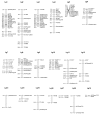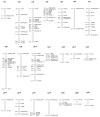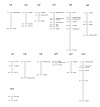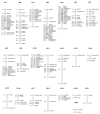A SSR-based composite genetic linkage map for the cultivated peanut (Arachis hypogaea L.) genome
- PMID: 20105299
- PMCID: PMC2835713
- DOI: 10.1186/1471-2229-10-17
A SSR-based composite genetic linkage map for the cultivated peanut (Arachis hypogaea L.) genome
Abstract
Background: The construction of genetic linkage maps for cultivated peanut (Arachis hypogaea L.) has and continues to be an important research goal to facilitate quantitative trait locus (QTL) analysis and gene tagging for use in a marker-assisted selection in breeding. Even though a few maps have been developed, they were constructed using diploid or interspecific tetraploid populations. The most recently published intra-specific map was constructed from the cross of cultivated peanuts, in which only 135 simple sequence repeat (SSR) markers were sparsely populated in 22 linkage groups. The more detailed linkage map with sufficient markers is necessary to be feasible for QTL identification and marker-assisted selection. The objective of this study was to construct a genetic linkage map of cultivated peanut using simple sequence repeat (SSR) markers derived primarily from peanut genomic sequences, expressed sequence tags (ESTs), and by "data mining" sequences released in GenBank.
Results: Three recombinant inbred lines (RILs) populations were constructed from three crosses with one common female parental line Yueyou 13, a high yielding Spanish market type. The four parents were screened with 1044 primer pairs designed to amplify SSRs and 901 primer pairs produced clear PCR products. Of the 901 primer pairs, 146, 124 and 64 primer pairs (markers) were polymorphic in these populations, respectively, and used in genotyping these RIL populations. Individual linkage maps were constructed from each of the three populations and a composite map based on 93 common loci were created using JoinMap. The composite linkage maps consist of 22 composite linkage groups (LG) with 175 SSR markers (including 47 SSRs on the published AA genome maps), representing the 20 chromosomes of A. hypogaea. The total composite map length is 885.4 cM, with an average marker density of 5.8 cM. Segregation distortion in the 3 populations was 23.0%, 13.5% and 7.8% of the markers, respectively. These distorted loci tended to cluster on LG1, LG3, LG4 and LG5. There were only 15 EST-SSR markers mapped due to low polymorphism. By comparison, there were potential synteny, collinear order of some markers and conservation of collinear linkage groups among the maps and with the AA genome but not fully conservative.
Conclusion: A composite linkage map was constructed from three individual mapping populations with 175 SSR markers in 22 composite linkage groups. This composite genetic linkage map is among the first "true" tetraploid peanut maps produced. This map also consists of 47 SSRs that have been used in the published AA genome maps, and could be used in comparative mapping studies. The primers described in this study are PCR-based markers, which are easy to share for genetic mapping in peanuts. All 1044 primer pairs are provided as additional files and the three RIL populations will be made available to public upon request for quantitative trait loci (QTL) analysis and linkage map improvement.
Figures




Similar articles
-
An integrated genetic linkage map of cultivated peanut (Arachis hypogaea L.) constructed from two RIL populations.Theor Appl Genet. 2012 Mar;124(4):653-64. doi: 10.1007/s00122-011-1737-y. Epub 2011 Nov 10. Theor Appl Genet. 2012. PMID: 22072100
-
Comparative mapping in intraspecific populations uncovers a high degree of macrosynteny between A- and B-genome diploid species of peanut.BMC Genomics. 2012 Nov 10;13:608. doi: 10.1186/1471-2164-13-608. BMC Genomics. 2012. PMID: 23140574 Free PMC article.
-
Utility of EST-derived SSR in cultivated peanut (Arachis hypogaea L.) and Arachis wild species.BMC Plant Biol. 2009 Mar 24;9:35. doi: 10.1186/1471-2229-9-35. BMC Plant Biol. 2009. PMID: 19309524 Free PMC article.
-
An Overview of Mapping Quantitative Trait Loci in Peanut (Arachis hypogaea L.).Genes (Basel). 2023 May 28;14(6):1176. doi: 10.3390/genes14061176. Genes (Basel). 2023. PMID: 37372356 Free PMC article. Review.
-
Advances in genetics and molecular breeding of three legume crops of semi-arid tropics using next-generation sequencing and high-throughput genotyping technologies.J Biosci. 2012 Nov;37(5):811-20. doi: 10.1007/s12038-012-9228-0. J Biosci. 2012. PMID: 23107917 Review.
Cited by
-
Peanut (Arachis hypogaea) Expressed Sequence Tag Project: Progress and Application.Comp Funct Genomics. 2012;2012:373768. doi: 10.1155/2012/373768. Epub 2012 Jun 17. Comp Funct Genomics. 2012. PMID: 22745594 Free PMC article.
-
Construction of a SNP-based genetic linkage map in cultivated peanut based on large scale marker development using next-generation double-digest restriction-site-associated DNA sequencing (ddRADseq).BMC Genomics. 2014 May 9;15(1):351. doi: 10.1186/1471-2164-15-351. BMC Genomics. 2014. PMID: 24885639 Free PMC article.
-
The genome sequences of Arachis duranensis and Arachis ipaensis, the diploid ancestors of cultivated peanut.Nat Genet. 2016 Apr;48(4):438-46. doi: 10.1038/ng.3517. Epub 2016 Feb 22. Nat Genet. 2016. PMID: 26901068
-
Diallel analysis, maternal effect and heritability in groundnut for yield components and oil content.Heliyon. 2024 Jun 21;10(12):e33379. doi: 10.1016/j.heliyon.2024.e33379. eCollection 2024 Jun 30. Heliyon. 2024. PMID: 39022008 Free PMC article.
-
Fostered and left behind alleles in peanut: interspecific QTL mapping reveals footprints of domestication and useful natural variation for breeding.BMC Plant Biol. 2012 Feb 17;12:26. doi: 10.1186/1471-2229-12-26. BMC Plant Biol. 2012. PMID: 22340522 Free PMC article.
References
-
- Doyle MC, Han IS. The roles of two TATA boxes and 3'-flanking region of soybean β-tubulin gene (tubB1) in light-sensitive expression. Mol Cells. 2001;12:197–203. - PubMed
-
- Krapovickas A, Gregory WC. Taxonomia del género Arachis (Leguminosae). [In Spanish, with English abstract] Bonplandia. 1994;8:1–186.
-
- Lanham PG, Fennell S, Moss JP, Powell W. Detection ofpolymorphic loci in Arachis germplasm using random amplified polymorphic DNAs. Genome. 1992;35:885–889. - PubMed
Publication types
MeSH terms
Substances
LinkOut - more resources
Full Text Sources
Research Materials

